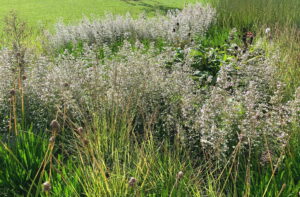Calamint
* Common name: Calamint

A patch of calamint in bloom.
* Botanical name: Calamintha nepeta subspecies nepeta
* What it is: Calamint is a mint-family perennial that spreads to make a dense, sun-loving groundcover but not to the over-aggressiveness of relatives like spearmint and pennyroyal, which can take over whole beds.
Calamint’s best attribute is how long its spiky white flowers last – non-stop for months starting in June and continuing into fall. Although it’s a European/Mediterranean native, its flowers are pollinator magnets. The foliage is gray-green.
This low-care plant was good enough overall to earn 2021 Perennial Plant of the Year honors from the Perennial Plant Association.
* Size: Including the flower spikes, plants grow about 18 inches tall. Space two to three feet apart.
* Where to use: Calamint is best used as a sunny groundcover, massed in a meadow-like planting, or mixed with other perennials in a pollinator garden. Full sun is best, although it’ll tolerate part shade. Avoid wet sites.
Deer and rabbits hardly ever bother calamint, so it’s a good choice in animal-threatened yards.
* Care: Water the first year to establish the roots, then calamint can usually get by on its own with even spotty summer rain. Fertilizer usually isn’t needed either.
Trim plants toward the end of the year if they’re getting floppy, then cut foliage nearly to the ground at the end of winter to make way for new growth.
Dig and divide fist-sized clumps in early spring or early fall if plants are spreading beyond where you want. Be aware that plants can self-seed, so watch for and remove any seedlings that also pop up where you don’t want.
* Great partner: None needed if you’re using calamint as a groundcover. The spiky white blooms look good underplanted with shrub roses, and ornamental grasses are good textural partners, especially prairie dropseed, little bluestem, and switchgrass.







